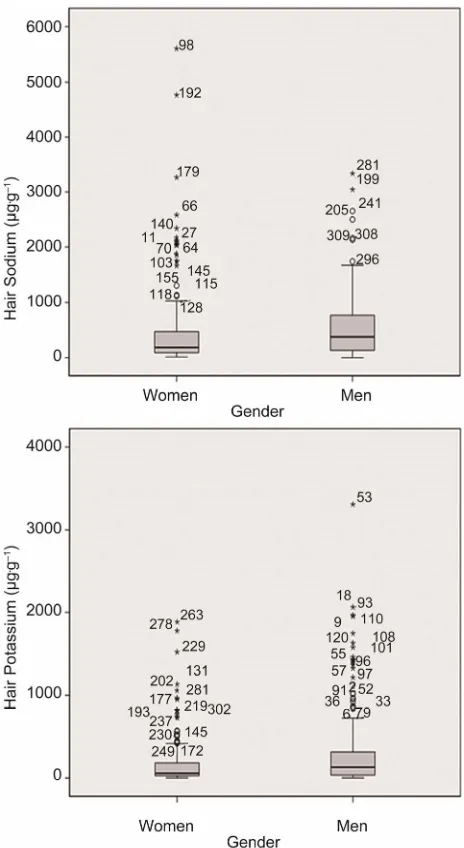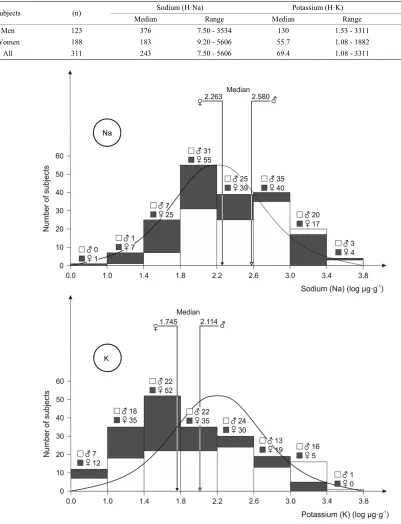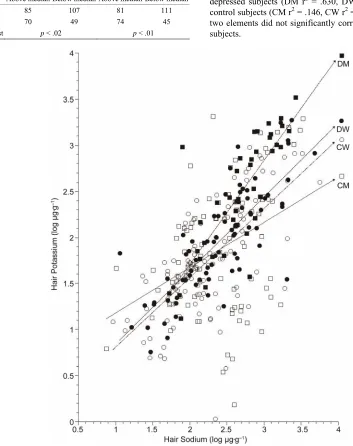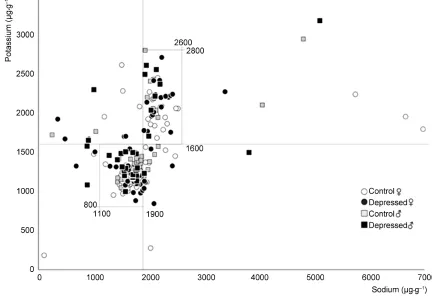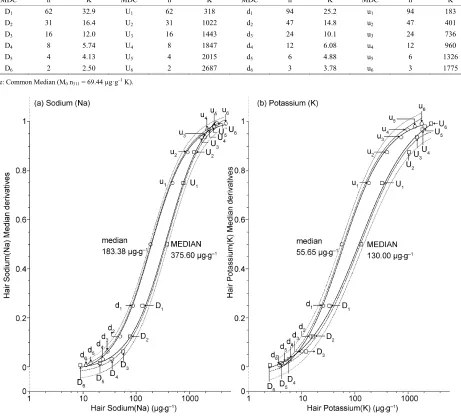2012. Vol.3, Special Issue, 825-833
Published Online September 2012 in SciRes (http://www.SciRP.org/journal/psych) http://dx.doi.org/10.4236/psych.2012.329125
The Muscle Immobility of Depression—The Weightlessness
Within
Berislav Mom
č
ilovi
ć
1*, Juraj Prejac
2, Vjeran Višnjevi
ć
1, Stipe Drmi
ć
3, Ninoslav Mimica
4,
Željka Bukovec-Megla
5, Sanja Brundi
ć
1, Anatoly Viktorovich Skalny
61Institute for Research and Development of the Sustainable Eco Systems, Zagreb, Croatia 2University Hospital Centre Zagreb, Zagreb, Croatia
3Neuropsychiatric Hospital “Dr. Ivan Barbot”, Popovača, Croatia 4University Psychiatric Hospital, Zagreb, Croatia
5Laboratory of Endocrinology, Clinic of Oncology and Nuclear Medicine,
University Hospital Center “Sestre milosrdnice”, Zagreb, Croatia
6ANO Center for Biotic Medicine, Moscow, Russia
Email: *berislav.momcilovic@gmail.com, juraj.prejac@gmail.com, vjeranv@gmail.com,
stipe.drmic@gmail.com, ninoslav.mimica@bolnica-vrapce.hr, zeljka.bukovec@kbcsm.hr, sanja.brundic@gmail.com, skalny3@orc.ru
Received June 4th,2012; revised July 10th, 2012; accepted August 7th, 2012
The purpose of the study was to elucidate the role of bioelements in human depression. We studied hair sodium and potassium in 311 adult subjects (188 women and 123 men) in the randomized, prospective, observational study; 192 were controls (83 men and 109 women), and 119 have major unipolar depression (40 men and 79 women). Depression was diagnosed by the DSM-IV criteria, and hair sodium and potas-sium were analyzed by the inductively coupled plasma atomic emission spectroscopy (ICP AES). In the subgroup of 19 controls and 24 depressed subjects who attempted suicide (the gravest form of major de-pression), antidiuretic hormone (ADH) was assessed by using the standard laboratory ADH diagnostic kit. Significant gender differences were observed, since men have more hair Na and K than women (Na p
< .01; K p < .02; Chi square test). The depressed subjects also have increased levels of hair Na and K,
what indicate the negative balance of these electrolytes, since hair growth is unidirectional (p < .01 for
both K and Na, Chi square test); ADH values were decreased in the suicidal subgroup (p < .01, Chi square test). These results on negative Na and K balance, and decreased ADH in depression, are pattern-identical to those observed in astronauts after the short term Apollo space missions. The question emerges if the observed Earthly metabolic changes of body muscles in depressed subjects are the direct consequence of the muscle inactivity, or the fatigue of depression is mediated by the failure of some hypothetical, gravity dependent muscle mobility brain control “dynamostat” that operates in conjunction with the fluid regula-tion center that manifest its presence when being weightless in the Space.
Keywords: Depression; Suicide; Hair; Blood; Sodium; Potassium; Vasopressin; Muscle Immobility;
Weightlessness
Introduction
Today, depression, and unipolar major depression in particu- lar, is the most prevalent mental health impairment of the man- kind (Kaplan & Sadock, 1995; Wong, 2005); the condition being twice as high in women as compared to men (Kessler et al., 1993). In medical terms depression is the core affective component of the mood disorders (The Merck Manual of Di- agnosis and Therapy, 1999). Indeed, unipolar depression is considered to be the condition of common and complex disor- der of gene-environment interactions for which the specific and environmental substrates are still unknown (Licino & Wong, 2005).
The semi-quantitative exploratory data analysis on a smaller population sample revealed that the multielement profile of hair is changed in depressed as compared to the control subjects (Momčilović et al., 2008, Momčilović et al., 2010). These pre- liminary studies showed, and to our surprise, that the greatest
change involved the negative balance of the major electrolytes Na and K in the depressed subjects. The aim of this study was to further scrutinize the reality of the observed phenomenon of depression related negative hair Na and K balance, and to ex- plore the separate role of gender and depression on Na and K metabolism. A subgroup of gravely depressed subjects who attempted suicide (Wulsin, 1996) was also included to assess the possible changes in the depression related antidiuretic hor-mone (ADH) secretion.
Subjects and Methods
Participants. This study was approved by the IRES Local
Ethical Committee and it was conducted by strict adherence to the Declaration of Helsinki on Human Subject Research (Brown, 2009), and to the complementary Croatian national bylaws and regulations; every subject gave his written consent to partici- pate in the study (Momčilović, 2011). No human research study in Croatia can be approved and funded without the clearance from the responsible Ethic Committee.
We studied hair sodium and potassium in 311 adult subjects (188 women and 123 men) in the randomized, prospective, observational study; 192 were controls (83 men and 109 wo- men), and 119 have major unipolar depression (40 men and 79 women). Depression was diagnosed in the outpatient psychiat- ric office by the licensed psychiatrists who followed the DSM- IV criteria (APA 2000). Most of the control and depressed sub-jects have lived in Zagreb, the capital of Croatia; the control subjects were those who were concerned about their health and well-being.
Methods and Procedures. The scalp hair was collected over
the easily palpable bony prominence at the back of the head (lat.
protuberantia occipitalis externa); whole blood was collected
by a venous puncture. Hair sodium (H·Na) and potassium (H·K), and whole blood sodium (WB·Na) and potassium (WB·K) were analyzed by the inductively coupled plasma atomic emis- sion spectroscopy (ICP AES) at the Center for Biotic Medicine, Moscow, Russia; an ISO certified high-tech laboratory, as al- ready reported in a great detail (Momčilović et al., 2006). All the results are expressed in µg·g–1.
The CBM detection limits for hair Na and K were 7.5 µg·g–1
and.45 µg·g–1, respectively. The normal CBM ranges for hair
Na were 80 - 850 µg·g–1 (men) and 50 - 250 (women), and for
hair K they were 50 - 250 µg·g–1 (men) and 25 - 110 µg·g–1
(women). The coefficient of variation for Na and K was 44% and 2.5%, respectively (Momčilović et al., 2009). The Na pleiad is characterized by 25 isotopes (1 O, 2 F, 5 Ne, 8 Na, 4 Mg, 4 Al, 1 Si), and that of K by 40 isotopes (2 S, 4 Cl, 6 Ar, 9 K, 8 Ca, 8 Sc, 3 Ti) (Momčilović et al., 2008).
In the subgroup of 19 controls and 24 depressed subjects who were admitted to hospital after the attempted suicide, an- tidiuretic hormone (ADH) was assessed in plasma with the ra- dioimmunoassay (RIA) (Glick & Kagan, 1979). Standard labo- ratory ADH diagnostic kit was used (Vasopressin Direct RIA, Buhlmann Laboratories AG, Schonenbuch, Switzerland); the manufacturer claimed normal vasopressin values (Mean ± SD) to be ≤ 6.7 pg·mL–1.
The results were expressed as either the median or the arith- metic mean with standard deviation. The different occurrence of Na and K in men and women and/or control and depressed subjects above and below the median were assessed with the Chi square test and MANOVA (Glantz, 2005). When there were gender difference between men and women, the frequency distribution of the median derivatives for H·Na and H·K con-centrations were further scrutinized by fitting the logistic re-gression analysis function, for men and women separately:
0
A2 A1 A2 1 x x p
where A1 is initial value (lower horizontal asymptote), A2 is final value (upper horizontal asymptote), x0 is center (point of
inflection; in our case it is the median M0), p is power (the parameter
that affects the slope of the area about the inflection point) (Appendix). We used the Qtiplot—Data Analysis and scientific visualization (www.soft.proindopendent.com/gbiplot.html) and Originpro 8.5.0 se 1 from Originlab Co., Northampton. MA, USA. The difference of p < .05 between the groups was
con-sidered to be significant.
Results
Hair Sodium and Potassium. We studied hair sodium and
potassium in 311 adult subjects (188 women and 123 men) in
the randomized, prospective, observational study; 192 were controls (83 men and 109 women), and 119 have major unipo- lar depression (40 men and 79 women). Sodium and potassium concentrations varied considerably for both men and women over a wide range of concentrations (Table 1). Visually, there
appears to be some (statistically insignificant) tendency to ac- cumulate more sodium and potassium in men than women, so that the median would be a better way of presenting the results than the arithmetic mean and the standard deviation/standard error (Figure 1). When data were log transformed (Figure 2)
[image:2.595.308.540.260.684.2]there appeared to be a gross difference between the lower me- dian concentrations of hair sodium and potassium in women than men, respectively. That data frequency distribution indi- cates that sodium and potassium hair concentrations peak ear- lier in women than in men, i.e., that there is a gender dependent peak shift.
Figure 1.
Box and whisker plot for the hair sodium and potassium concentrations (µg·g–1). Box 25 - 75 percentiles; bold line within in the box is median;
Table 1.
Hair sodium and potassium data (µg·g–1).
Sodium (H·Na) Potassium (H·K) Na/K
Subjects (n)
Median Range Median Range Median
Men 123 376 7.50 - 3534 130 1.53 - 3311 2.89
Women 188 183 9.20 - 5606 55.7 1.08 - 1882 3.29
All 311 243 7.50 - 5606 69.4 1.08 - 3311 2.45
Figure 2.
Hair sodium (Na) and potassium (K) data frequency distribution (log). □Men (♂); ■ Women (♀);▽ Median Men (Na 2.589, K 2.114); ▼ Median Women (Na 2.263, K 1.745).
Gender. When we compared the frequency distribution of
hair sodium and potassium concentrations above and below the median (Na 243 and K 69.4 µg·g–1,
Table 1), it become evident
that men have more sodium and potassium in their hair than do the women (p < .01 for both elements) (Table 2). Similarly,
depressed subjects have more sodium and potassium in their
hair than the control subjects (sodium p < .02, potassium p
< .01) (Table 3). MANOVA (not shown here) also confirmed
Table 2.
Hair sodium and potassium accumulation depend upon the gender (data frequency).
Sodium Potassium Above median Below median Above median Below median
Men 74 49 73 50
Women 81 107 82 106 Chi square test p < .01 p < .01
Table 3.
Depression affects sodium and potassium hair deposition (data fre- quency).
Sodium Potassium Above median Below median Above median Below median Control 85 107 81 111
Depression 70 49 74 45
Chi square test p < .02 p < .01
When it comes for sodium, MANOVA only weekly confirmed that depressed subjects have somewhat more sodium in their hair (p < .10), and that men also tend to have more sodium than
women in their hair (p < .15).
Hair Sodium vs. Hair Potassium. The scatter plot of hair
sodium vs. hair potassium showed different behavior if the sub- ject was men or women and if he/she was depressed or not (Figure 3). The regression line was the steepest for men having depression (DM), but the lowest in control men (CM). In be- tween these depressed men and control men there were both depressed and control groups of women, respectively. Again, the slope for the depressed women (DW) was slightly steeper than that of the control women (CW). It should be noted that the correlation of sodium vs. potassium was much better in the depressed subjects (DM r2 = .630, DW r2 = .628) than in the
control subjects (CM r2 = .146, CW r2 = .461); apparently these
[image:4.595.98.451.240.686.2]two elements did not significantly correlate in the control men subjects.
Figure 3.
Scatter plot of the hair sodium to potassium (log Na vs. log K). □ CM control men (n = 83), Y = .494X + .682 (r2 = .146); ■ DM depressed men (n = 40), Y = 1.130X +.628 (r2 = .628); ○ CW
control women (n = 109), Y = 0.755X + 0.053 (r2 = .461); ● DW depressed women (n = 79). Y
Blood Na and K. We also studied the scatter plot of whole
blood sodium and potassium (Figure 4), with even the more
disappointing result, i.e., the correlation appears to be non- existent. By visual examination of the plot, we rather arbitrarily identified two clusters (boxed), one of them what we called Low sodium Low potassium cluster (bottom left), and a High sodium High potassium cluster (top right). Thus far we can only say that the High sodium High potassium cluster contained the slightly older subjects than the Low Sodium, Low potas- sium cluster (p < .10).
Median Derivatives. Because of the observed gender dif-
ference, the frequency distribution of the median derivatives for H·Na and H·K concentrations was further scrutinized by fitting
the logistic regression analysis function, for men and women separately (Figure 5, Left panel Na, Right panel K). Data to fit
the equation are shown separately for sodium (Table 4), and
potassium (Table 5). The H·Na below 28.8 (d3) and 56.5 (D3)
µg·g–1 for women and men, respectively, reflect low level of
sodium intake. The adaptive, bioassay like physiological satu- rationn phase followed, where H·Na rose rapidly, first for women and then for men. Both, now separated parallel satura- tion curves, would converge and plateau above 909 (u2) and
1223 (U2) µg·g–1 for women and men, respectively. Indeed,
[image:5.595.77.509.242.542.2]between these end points at the beginning and at the plateau, there were two distinct phase shifts saturation slopes for women and men, respectively. Women started to accumulate sodium in
Figure 4.
[image:5.595.57.539.614.725.2]Scatter plot of the whole blood sodium and potassium. □ CM control men, ■ DM depressed men; ○ CW control women; ● DW depressed women. Tentative clusters are boxed: Low Na Low K cluster (left down), High Na High K cluster (upper right).
Table 4.
Hair Sodium median derivative concentrations (MDC) (µg·g–1). Men (D
1-D6 downward MDC, U1-U6 upward MDC); Women (d1-d6 downward MDC,
u1-u6 upward MDC).
MEN WOMEN Median (M0 n123 = 375.60 µg·g–1Na) Median (M0 n188 = 183.38 µg·g–1 Na)
MDC n Na MDC n Na MDC n Na MDC n Na
D1 62 130 U1 62 766 d1 94 86.3 u1 94 473
D2 31 75.7 U2 31 1223 d2 47 49.6 u2 47 909
D3 16 56.5 U3 16 1675 d3 24 28.8 u3 24 1955
D4 8 34.6 U4 8 2331 d4 12 23.4 u4 12 2150
D5 4 20.6 U5 4 2848 d5 6 13.7 u5 6 2921
D6 2 8.83 U6 2 3189 d6 3 11.3 u6 3 4763
Table 5.
Hair Potassium median derivative concentrations (MDC) (µg·g–1). Men (D
1-D6 downward MDC, U1-U6 upward MDC); Women (d1-d6 downward
MDC, u1-u6 upward MDC).
MEN WOMEN Median (M0 n123 = 130.00 µg·g–1 K) Median (M0 n188 = 55.65 µg·g–1 K)
MDC n K MDC n K MDC n K MDC n K
D1 62 32.9 U1 62 318 d1 94 25.2 u1 94 183
D2 31 16.4 U2 31 1022 d2 47 14.8 u2 47 401
D3 16 12.0 U3 16 1443 d3 24 10.1 u3 24 736
D4 8 5.74 U4 8 1847 d4 12 6.08 u4 12 960
D5 4 4.13 U5 4 2015 d5 6 4.88 u5 6 1326
D6 2 2.50 U6 2 2687 d6 3 3.78 u6 3 1775
[image:6.595.68.529.152.570.2]Note: Common Median (M0 n311 = 69.44 µg·g–1 K).
Figure 5.
(a) The difference between the hair Sodium median derivatives of Men n = 123 (□) and Women n = 188 (○). D, U Men downward (D) and upward (U) median derivatives, d, u Women downward (d) and upward (u) median derivatives. ··· Logistic function:
2 1 2 0
A + A A 1 X X p, ··· 0.95 confidence limit, ··· 0.95 prediction limit. Men: Y 1.075
.013 1.075
1
X 381.737
1.223 ,
Women: Y 1.005
.029 1.005
1
X 187.118
1.257 (see Appendix for model and Table 4. for input values); (b) The difference between the hair Potassium median derivatives of Men n = 123 (□) and Women n = 188 (○). D, U Men downward (D) and upward (U) me-dian derivatives, d, u Women downward (d) and upward (u) meme-dian derivatives. ··· Logistic function: A2 + (A1 – A2)/(1 + (X/X0)p), ··· 0.95confidence limit, ··· 0.95 prediction limit. Men: Y 1.060
.040 1.060
1
X 123.81
0.86 , Women:
1.054Y 1.013 .065 1.013 1 X 57.455 (see Appendix for model and Table 5 for input values).
hair earlier than men, and also reach saturation point earlier
D3, and then again above the upward u2 and U2 median deriva-
tives for women and men, respectively.
Similarly, the hair potassium (H·K) below 14.8 (d2) and 16.4
(D2) µg·g–1 for women and men, respectively, reflect low level
of potassium intake. Then, again, there is a rapidly growing H·K saturation phase of two distinct, semi parallel saturation curves, first for women and then for men. Both saturation curves converge and plateau above 401 (u2) and 1022 (U2)
µg·g–1 for women and men, respectively. It should be noted that
the separation of convergent lines above the median is wider for potassium than sodium, i.e., the growing slope for potassium in men covers the wider range of concentrations than that for women. Thus, there are subtle differences between logistic re- gression curves not only between the men and women, but also between the sodium and potassium.
The levels of the antidiuretic hormone (ADH, vasopressin) were diminished in subjects who attempted suicide in compare- son to the healthy control (p < .01) (Table 6).
Discussion
Hair is the biological indicator tissue of great potential—it is easily accessible, collection is painless, can be simply stored to wait for analysis—and adequately reflects the metabolic changes due to the subtle changes of partition in the intermediary me-tabolism (Cutler 2004, Wilson 2010). Hair is the dynamic tissue structure—some hair follicles are active (anagen phase), the other are dormant (telogen phase), and some of them degener-ate only to arise anew ldegener-ater on (Hordinsky, 2003). Hordinsky (2003) also showed that the rate of division of human hair folli-cle cells is second only to the bone marrow cells, which reflects accurately the metabolic changes within the body. Indeed, as the hair growth irreversibly from the follicle to the tip, it is a cumulative log of all the metabolic changes of the elements that pass through the follicle.
This study confirmed our preliminary observations that hair sodium and potassium concentrations are increased in the hair of depressed subjects (Momčilović et al., 2008, 2010). More- over, this study showed the profound gender dependent meta- bolic difference in storing sodium and potassium in the hair; both elements were higher in men than women hair. We think that the observed changes of negative Na and K metabolic bal- ance are related to the muscle inactivity of the depressed sub- jects. Indeed, the increased concentrations of hair sodium and potassium are not the results of the increased sodium and po- tassium intake in the depressed subjects, but are the cones- quence of their impaired partition in the intermediary metabo- lism that favors sodium and potassium elimination from the body (negative balance) by the increased elimination via the hair. That hair elimination route appears to be enhanced by the decreased secretion of the vasopressin in subjects who at- tempted suicide (the gravest form of depression).
[image:7.595.56.287.679.716.2]Our observation of increased hair K and Na, i.e., their nega- tive balance, and reduced serum vasopressin in depressed sub-
Table 6.
Plasma ADH* in subjects who attempted suicide (Mean ± SD).
Subjects (n) Men/Women ADH (pg·mL–1)
Control 19 7/12 4.264a ± 1.564
Attempted Suicide 24 8/16 3.376b ± 1.567
Note: *
ADH-antidiuretic hormone (vasopressin), a,b
Means bearing various super-scripts in the same column differ significantly (p < .01).
jects are pattern-identical to those observed in astronauts after the short term Apollo space missions. Berry (1973, 1974) re- ported a slight decrease in total body water and a plasma vol- ume decrease of almost eight percent accompanied with the decrease of total body exchangeable potassium of about ten percent. Fluid balance data for the Apollo 17 crew suggested that the observed major weight loss was body tissue loss and not attributable to water imbalance. Negative nitrogen and po- tassium balances confirmed that this tissue loss was principally a loss of body proteins, that is, muscle. Some of the weight loss observed must be attributed to a loss of fluid because of the slight decrease in total body water noted post-flight, confirmed by decreases in urinary electrolytes and antidiuretic hormone. The question emerges if the observed Earthly metabolic changes of body muscles in depressed subjects are the direct consequence of the muscle inactivity, or the fatigue of depress- sion is mediated by the failure of some hypothetical, gravity dependent muscle mobility brain control “dynamostat” that operates in conjunction with the fluid regulation center that manifest its presence when being weightless in the Space. Thus, the muscle immobility of depression would be reflected by the increased amounts of available potassium and sodium due to the impaired partitioning processes of the intermediary metabo- lism.
Certainly, gravity plays an important alostatic (ongoing ef- forts to maintain homeostasis) role in the biology of cell life (McEwens, 2007) since it cued the organization of microtubular dissipative structures (Tabony & Job, 1992). Indeed the intra- cellular fluid volume increased during the space flight (Leach et al., 1996), and what certainly increases the cell energy spending to keep the cellular osmotic volume; cells spent the most of their energy to keep their osmotic sustainability (Baumgarten & Feher, 1988). Apparently, a lot of research is needed to eluci-date the already observed contradictions in metabolism of elec-trolytes and hormones in relation to the motility and weight-lessness (Lane & Feeback, 2002). The observed gender differ-ence in hair sodium and potassium reflects an addition to the already reported numerous differences observed in the body composition of women and men (Shills et al., 1999). Appar-ently, thus far, too little attention was paid to get down to the metabolic core of the gender differences in body composition; evident biological gender differences should not be confused with the gender rights to the political equality.
The molecular biology of major human depression, and the role of major electrolytes like sodium and potassium, is not well understood—certain aspects of depression result from maladaptive stress induced neuroplastic changes in specific neural circuits where KCNJ11 potassium inwardly rectifying channel J11 gene is involved (Krishnan & Nestler, 2008). In-deed, Fava and Kendler (2000) summarized the research of Xie and McCobb (1998) on how adrenocorticotrophic hormones produced in the pituitary control the excitable properties of epinephrine-secreting cells of the adrenal gland by regulating alternative splicing of the Ca2+- activate K+ channel, Slo
dorso-lateral neurons of the spine that control the motility (Caldwell et al., 2008). The muscle immobility of depression opens new research possibilities for the biological psychiatry. Further stu- dies are needed to elucidate the role of other bioelements in the depression and to embrace their entangled gestalt with cellular osmosis, hormones, and physical activity control. Our results support the assumption of Caldwell et al. (2008) on diminished levels of ADH in depressed subjects.
Conclusion
Men accumulate more sodium and potassium in the hair than women.
Depressed subjects also accumulate more Na and K in the hair than the control subjects.
Antidiuretic hormone (ADH, vasopressin) is diminished in subjects who attempted suicide.
Muscle inactivity/immobility of depression mirrors the mus- cle waste of weightlessness.
Acknowledgements
This study was supported in part by the Croatian Ministry of Science, Education, and Sport grant No. 292-0222412-2405 (formerly No. 022-0222412-2405).The generous philanthropic support of the RCM, Isle of Man, UK to the first author is greatly appreciated.
REFERENCES
American Psychiatric Association (APA) (2000). Diagnostic and statis- tical manual of mental disorders (DSM IV). Washington, DC: Author. Baumgarten, C. M., & Feher, J. J. (1998). Osmosis and the regulation
of cell volume. In N. Sperelakis (ed.), Cell physiology source book
(2nd ed., pp. 253-292). San Diego, CA: Academic Press.
Beers, M. H., & Betkow, R. (1999). The Merck Manual of Diagnosis and Therapy (17th ed.) Whitehouse Station, NJ: Merck, 1525-1544. Berry, C. A. (1973). Weightlessness. In J. F. Parker, & V. R. West, (eds.),
Bioastronautics data book (pp. 349-415). Washington, DC: US Gov-
ernment Printing Office.
Berry, C. A. (1974). The medical legacy of Apollo. Aerospace Medi- cine, 45, 1046-1957.
Brown, M. (2009), Charter of rights is adopted in the UN, New York Times. URL.
http://www.nytimes.com/learning/general/onthisday/big//0618.html Caldwell, H. K., Lee, H.-J., Macbeth, A. H., & Young III, W. S. (2008).
Vasopressin: Behavioral roles of an “original” Neuropeptide. Pro- gress in Neurobiolog, 84, 1-24.
doi:10.1016/j.pneurobio.2007.10.007
Cutler, A. H. (2004). Hair test interpretation: Finding hidden toxicities. URL. http://www.noamalgam.com/buythebooks.html
De Winter, R. F. P., van Hemert, A. M, DeRijk, R. H. D., Zwinderman, K. H., Frankhuijzen-Sierevogel, A. C., Wiegant, V. M., & Goekoop, J. G. (2003). Anxous-retarded depression: Relation with plasma vaso- pressin and cortisol. Neuropsychopharmacology, 28, 140-147.
doi:10.1038/sj.npp.1300002
Fava, M., & Kendler, K. S. (2000). Major depressive disorder. Neuron, 28, 335-341. doi:10.1016/S0896-6273(00)00112-4
Glantz, S. A. (2005). Primer of biostatistics (6th ed.). New York: Mc-
Graw Hill.
Glick, S. M., & Kagan, A. (1979). Radioimmunoassay of arginine vaso- pressin. In B. M. Jaffe, & H. R. Behrmann (Eds.), Methods of hor- mone radioimmunoassay. New York: Academic Press.
Hordinsky, M. K. (2003). Alopecia. In J. L. Bolognia, J. L. Jorizzo, & R. P. Rapini (eds.), Dermatologia (pp. 1033-1059). Edinburgh: Mosby. Kaplan, H. I., & Sadock, B. J. (Eds.) (1995). Comprehensive textbook
of Psychiatry (6th ed.). Baltimore: Williams and Wilkins.
Kessler, R. C., McGonagle, K. A., Swartz, M., Blazer, D. G., & Nelson, C. B. (1993). Sex and depression in the National Comorbidity Study Survey: Lifetime prevalence, chronicity, and recurrence. Journal of Affective Disorders, 29, 85-96. doi:10.1016/0165-0327(93)90026-G Krishnan, V., & Nestler, E. J. (2008). The molecular neurobiology of
depression. Nature, 455, 894-902. doi:10.1038/nature07455
Lane, H. W., & Feeback, D. L. (2002). Water and energy dietary re- quirements and endocrinology of human space flight. Nutrition, 18,
820-828. doi:10.1016/S0899-9007(02)00936-X
Leach, C. S., Alfrey, C., Suki, W. N., Leonard, J. I., Rambaut, P. C., & Inners, L. D. (1996). Regulation of body fluid compartments during short-term space flight. Journal of Applied Physiology, 81, 105-116. Licino, J., & Wong, M.-L. (2005). Biology of depression (Preface).
Weinheim: Wiley-VCH Verlag GmbH and Co. doi:10.1002/9783527619672
McEwens, B. S. (2007). Physiology and neurobiology of stress and adaptation: Central role of the brain. Physiological Reviews, 87, 873- 934. doi:10.1152/physrev.00041.2006
Momčilović, B. (2011). Are two heads better than one even if one is a cabbage?—Memories and reflections on the project peer review practices in Croatia. Periodicum biologorum, 113, 21-27.
Momčilović, B., Morović, J., Ivičić, N., & Skalny, A. V. (2006). Hair and blood multielement profile for metabolic imaging of the major unipolar depression: Study rationale and design. Trace Elements in Medicine (Moscow), 7, 33-42.
Momčilović, B, Morović, J, Prejac, J, Skalny, A. V., & Ivičić, N. (2008). Trace element profile of human depression—The tapestry of patterns.
Trace elements and electrolytes, 25, 187-190.
Momčilović, B., Prejac, J., Brundić, S., Morović, S., Skalny, A. V., Mi- mica, N., & Drpić, S. (2010). An essay on human and elements, mul-tielement profiles, and depression. Translational Neuroscience, 1,
322-334. doi:10.2478/v10134-010-0039-2
Momčilović, B., Prejac, J., & Ivičić, N. (2009). A case report on ana- lytical reproducibility of the human multielement profile. A two years follow up. Trace Elements in Medicine (Moscow), 10, 33-38.
Momčilović, B., Prejac, J., Momčilović, R., Ivičić, N., Veber, D., & Lyk- ken, G. I. (2008). On the same element isotope mass number (pleiad) and the clusters of elements sharing the same mass numbers in the Periodic system—The “cheshya” (fish skin) model. Trace Elements in Medicine (Moscow), 9, 5-20.
Shills, M. E., Olsen, J. A., Shika, M., & Ross, A. C. (1999). Modern nutrition in health and disease. Baltimore, MD: Williams and Wil- kins, 751-771.
Smylevich, I., & Dougherty, E. R. (2010). Probabilistic Boolean net- works. Philadelphia, PA: Society for Industrial and Applied Mathe-
matics, 227-241. doi:10.1137/1.9780898717631.ch6
Tabony, J., & Job, D. (1992). Gravitational symmetry breaking in mi- crotubular dissipative structures. Proceedings of the National Acad- emy of Sciences, 89, 6948-6952. doi:10.1073/pnas.89.15.6948
Willson, L. (2010). Nutritional balancing and hair mineral analysis (4th ed.). URL. http://www.drlwilson.com
Wong, M.-L. (2005). History and epidemiology of depression. In J. Licino, & M.-L. Wong (eds.), Biology of depression: From novel in- sights to therapeutics strategies (pp. 653-667). Weinheim: Wiley- VCH Verlag GmbH and Co.
Wulsin, L. R. (1996). Depressive disorders. In J. L. Jacobson, & A. M. Jacobson (eds.), Psychiatric secrets (pp. 74-79). Philadelphia/St Louis: Hanley and Belfus Inc./Mosby.
Xie, J., & McCobb, D. P. (1998). Control of alternative splicing of potassium channels by stress hormones. Science, 280, 443-446.
Appendix
.
The median derivatives model (Population Size, PS = 1.000).
MEDIAN (M0)
<--->◘<---> Median Derivative Downward Branch Median Derivative Upward Branch
(D0, n = 155 = PS 0.500) (U0, n = 155 = PS 0.500) Descending Median Derivatives Ascending Median Derivatives D1 D0/2 0.250 U1 D0 + A0/2 0.750 <---◘---><---◘---> D2 D0/4 0.125 U2 D0 + A0/4 0.875
<---◘---><---◘--->
D3 D0/8 0.062 U3 D0 + A0/8 0.937 <---◘---><---◘--->
D4 D0/16 0.031 U4 D0 + A0/16 0.969 <----◘----><---◘--->
D5 D0/32 0.016 U5 D0 + A0/32 0.983 --◘-- --◘-- D6 D0/64 0.008 U6 D0 + A0/64 0.992 -◘- -◘-
We studied the frequency distribution of the studied hair element median and it’s derivatives to assess element’s insuffi-ciency, adequacy, and overexposure. First we assess the median (M0) hair silver concentration of our subject population. By de- finition, one half of the studied population was above the me-dian (upward or ascending meme-dian branch, U0), and the other half was below the median (downward or descending median branch, D0). Hence, the population size (PS) for M0 is the sum of the respective upward and downward median branches around the central inflection “hinge” M0, i.e., PS = U0 + D0 = 0.5 +
